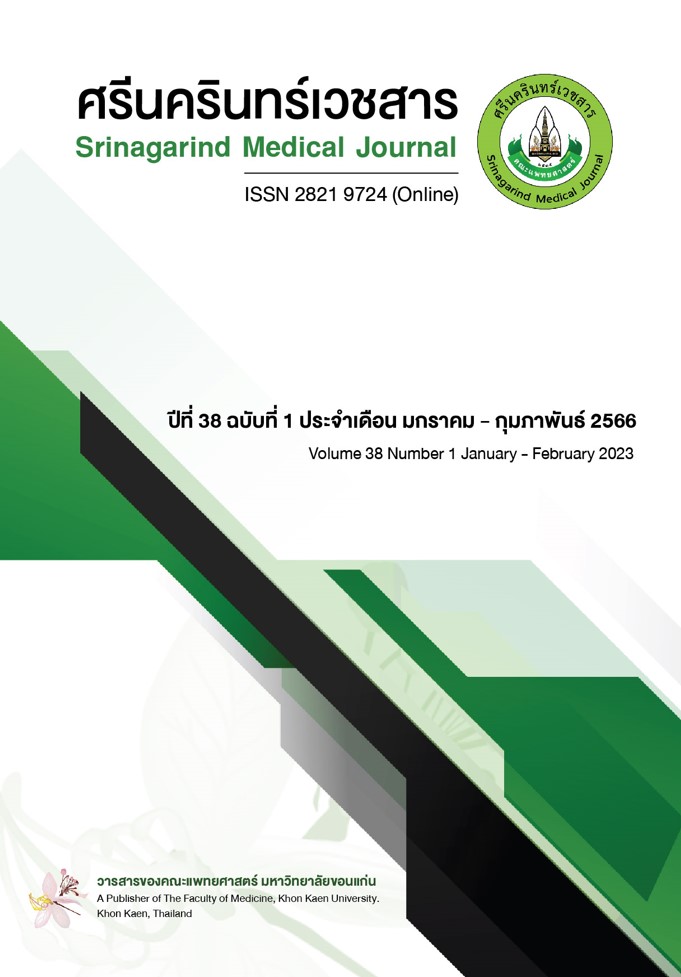ประสิทธิผลของยา Deferiprone (GPO-L-ONE®) ชนิดรับประทานในผู้ป่วยเด็กโรคธาลัสซีเมียที่มีภาวะธาตุเหล็กเกินในโรงพยาบาลกระบี่
Abstract
Effectiveness of Oral Deferiprone (GPO-L-ONE®) in Pediatric Thalassemia Patients with Iron Overload, in Krabi Provincial Hospital
Sunjutha Sudjan
Krabi Hospital, Krabi Province
วัตถุประสงค์: เพื่อศึกษาประสิทธิผลของยา Deferiprone (GPO-L-ONE®) ชนิดรับประทานในผู้ป่วยเด็กโรคธาลัสซีเมียที่มีภาวะธาตุเหล็กเกิน
วิธีการศึกษา: เก็บข้อมูลย้อนหลังของผู้ป่วยเด็กที่ได้รับการวินิจฉัยเป็นโรคธาลัสซีเมียและมีภาวะธาตุเหล็กเกิน (ระดับ serum ferritin มากกว่า 1,000 ไมโครกรัมต่อลิตร) ระหว่าง ปี พ.ศ. 2561 ถึง 2564 ที่ได้รับการรักษาด้วยยา GPO-L-ONE® และตรวจวัดระดับ serum ferritin ทุก 6 เดือน เป็นเวลา 30 เดือน ใช้การวิเคราะห์แบบ Paired t–test และ repeated measurement ANOVA
ผลการศึกษา: ผลการศึกษาพบผู้ป่วยเด็กโรคธาลัสซีเมียที่เข้าร่วมการศึกษาจำนวน 180 ราย อายุเฉลี่ย 7.53 ± 3.73 ปี เป็น β-thalassemia / Hb E disease ร้อยละ 50.00 Homozygous β-thalassemia ร้อยละ 46.11 และ Hb H Constant Spring ร้อยละ 3.89 หลังรับประทานยาขับเหล็ก GPO-L-ONE® เป็นเวลา 12, 18, 24 และ 30 เดือน ค่าเฉลี่ยระดับ serum ferritin ลดลงอย่างมีนัยสำคัญทางสถิติเมื่อเปรียบเทียบก่อนรับประทานยา (p=0.004, 0.014, 0.02 และ 0.02, Mean difference = -118, -137, -170 และ -207 ไมโครกรัมต่อลิตร ตามลำดับ) ผู้ป่วยเด็กโรคธาลัสซีเมีย จำนวน 56 ราย ที่ได้รับการติดตาม ระดับ serum ferritin ทุก 6 เดือน จนครบ 30 เดือน พบค่าเฉลี่ยระดับ serum ferritin ก่อนและหลังรับประทานยาลดลงเล็กน้อย จาก 1282±216 เหลือ 1075±619 ไมโครกรัมต่อลิตร อาการไม่พึงประสงค์ที่พบบ่อย คือ ระดับเอนไซม์ตับเพิ่มขึ้นและเม็ดเลือดขาวชนิดนิวโทรฟิลต่ำ
สรุป: ยา GPO-L-ONE® มีประสิทธิผลในการรักษาภาวะธาตุเหล็กเกินแต่ต้องเฝ้าติดตามระดับเอนไซม์ตับเพิ่มขึ้นและเม็ดเลือดขาวชนิดนิวโทรฟิลต่ำอย่างใกล้ชิด
Objective: To study the effectiveness of oral deferiprone (GPO-L-ONE) in pediatric thalassemia patients with iron overload.
Method: A retrospective descriptive study was conducted in pediatric thalassemia patients who had serum ferritin levels above 1,000 µg/L treated with GPO-L-ONE® chelation since 2018 to 2021. Serum ferritin levels were measured every six months and patients were followed up for 30 months. In addition, laboratories and clinical safety monitoring were performed. Paired t–test and repeated measurement ANOVA were used to analyze data.
Result: One hundred and eighty pediatric thalassemia patients were included in this study and they had 7.53 ± 3.73 years of average age with either β-thalassemia/Hb E disease (50%) or Homozygous β-thalassemia (46.11%) or Hb H Constant Spring (3.89%). After treatment for 12, 18, 24 and 30 months, serum ferritin levels were decreased significantly (p=0.004, 0.014, 0.02 and 0.02, Mean difference = -118, -137, -170 and -207 µg/L respectively). Only 56 patients were completely followed up every 6 months for 30 months and the serum ferritin levels at before and after treatment of this group were compared and the levels were nosignificantly decreased from 1282±216 to 1075±619 µg/L. The most common adverse drug reactions observed in patients were increased transaminase followed by neutropenia.
Conclusion: GPO-L-ONE® is an effective oral iron-chelating agent for treatment in pediatric thalassemia with iron overload. However, safety monitoring especially increased transaminase and neutropenia should be closely observed.
Downloads
Published
Issue
Section
License

This work is licensed under a Creative Commons Attribution-NonCommercial-NoDerivatives 4.0 International License.


